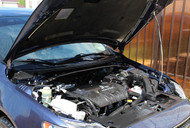Running Rich or Lean? Check Your Air Fuel Ratio Sensor
8th Jun 2023

You can't ignore a rich- or lean-running engine. A rich-running engine will consume too much gas, whereas a lean-running engine won't consume enough gas. In either case, your vehicle will perform poorly, and it will be exposed to increased wear and tear that results in higher maintenance costs.
What Is an Air Fuel Ratio Sensor?
An air fuel ratio sensor is a device that's designed to measure the oxygen content in the exhaust gases. Also known as a lambda sensor, it tells the vehicle's power control module (PCM) how much oxygen is in the exhaust gas. Using this information, the PCM will adjust the air fuel ratio.
Air Fuel Ratio Sensors vs O2 Sensors
The terms "air fuel ratio sensors" and "O2" sensors are often used interchangeably. Many motorists -- and even mechanics for that matter -- assume they are the same. Air fuel ratio sensors and O2 sensors, however, are different.
Most vehicles will have either an air fuel ratio sensor, or they will have an O2 sensor. Air fuel ratio sensors are more advanced than their O2 counterpart. While they are both designed to measure the oxygen content in exhaust gases, air fuel ratio sensors support a wider range. They can precisely measure the oxygen content, even if the engine is running extremely rich or extremely lean.
How a Bad Air Fuel Ratio Sensor Can Affect Your Vehicle
If your vehicle has a bad air fuel ratio sensor, it may not consume the correct ratio of air to fuel. Internal combustion engines (ICE) run on more than just gas; they require air as well. A typical vehicle uses an air fuel ratio of about 14.7:1. This means for every one unit of air that enters the combustion chamber, 14.7 units of fuel will enter the combustion chamber.
The air fuel ratio sensor ensures the proper balance between air and fuel. It will measure the oxygen content in your vehicle's exhaust gases, and it will send this information to your vehicle's PCM so that it can adjust the fuel consumption. With a bad air fuel ratio, it may send the wrong information to your vehicle's PCM.
Your vehicle may think there's too much or too little oxygen in the exhaust gas. The bad air fuel ratio sensor will send this erroneous information to your vehicle's PCM. Your vehicle will then increase or decrease the flow of fuel to the combustion chamber, resulting in a lean- or rich-running engine. Replacing the bad air fuel ratio sensor will solve this problem.



